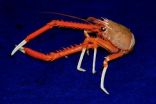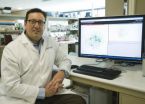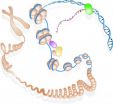(Press-News.org) HOLLYWOOD Fla. — Some deep-sea crabs have eyes sensitive to ultraviolet light, which they may use to snatch glowing plankton and stuff it in their mouths, a new Nova Southeastern University study suggests.
Tamara Frank, Ph.D., a marine biologist and associate professor at Nova Southeastern University's Oceanographic Center, who is the principal investigator of the study, said that crabs living the deep-sea zone --- a pitch dark area at the ocean bottom ---- may be using bioluminescence to help sort out their food.
Duke University marine biologist Sönke Johnsen. Ph.D., one of the study's collaborators, explained that the animals might be using their ultraviolet and blue-light sensitivity to sort out the likely toxic corals they're sitting on ---- which glow, producing blue-green and green bioluminescence --- from the plankton they eat, which glow blue.
The sensitivity to shorter ultraviolet wavelengths may give the crabs a form of color vision to guarantee they grab healthy grub, not poison. Frank and her collaborators reported the findings in the Sept. 6 issue of the Journal of Experimental Biology.
Frank has previously shown that certain deep-sea shrimp living in the water column can see ultraviolet wavelengths, even though they live nearly half a mile below the ocean surface, where there's little to no sunlight. Experiments to test deep-sea creatures' sensitivity to light have rarely been done on animals that live on the bottom of the ocean. The new study is one of the first to test how bottom-dwelling animals respond to light.
The team of scientists studied three ocean-bottom sites near The Bahamas. They took video and images of the regions, recording how crustaceans ate and the wavelengths of light, or color, at which neighboring animals glowed by bioluminescence. The scientists also captured and examined the eyes of eight crustaceans found at the sites and several other sites on earlier research cruises.
To capture the crustaceans, the team used the Johnson-Sea-Link submersible. During the dive, crustaceans were gently suctioned into light-tight, temperature-insulated containers. They were brought to the surface, where Frank placed them in holders in her shipboard lab and attached a microelectrode to each of their eyes.
She then flashed different colors and intensities of light at the crustaceans and recorded their eye response with the electrode. From the tests, she discovered that all of the species were extremely sensitive to blue light and two of them were extremely sensitive to both blue and ultraviolet light. The two species sensitive to blue and UV light also used two separate light-sensing channels to make the distinction between the different colors. It's the separate channels that would allow the animals to have a form of color vision, said Johnsen, who is an expert in optics.
During a sub dive, Johnsen used a small, digital camera to capture one of the first true-color images of the bioluminescence of the coral and plankton at the sites. In this "remarkable" image, the coral glows greenish, and the plankton, which is blurred because it's drifting by as it hits the coral, glows blue, he said.
Video of the crabs placidly sitting on a sea pen, periodically picking something off corals and putting it in their mouths, and the data showing the crabs' sensitivity to blue and UV light, suggests that they have the ability color code their food. The idea is "still very much in the hypothesis stage, but it's a good idea," Johnsen said.
To further test the hypothesis, the scientists need to collect more crabs and test the animals' sensitivity to even shorter wavelengths of light. That might be possible, but the team will have to use a different sub, since the Johnson-Sea-Link is no longer available.
Another challenge is to find out whether the way the crabs are acting in the video is natural.
"Our subs, nets and ROVs greatly disturb the animals," Johnsen said. "So we're stuck with what I call forensic biology. We collect information about the animals and the environment, and then try to piece together the most likely story of what happened."
The story looks like deep-sea crabs are color-coding their food, he said.
INFORMATION:
About Nova Southeastern University's Oceanographic Center: A world leader in marine biological research with focus on coral reef science and shark conservation, Nova Southeastern University's Oceanographic Center has been at the forefront of graduate and undergraduate marine science education and oceanographic research for over 48 years. Students, scientists, faculty and staff come to the Center from all corners of the globe, with the common goal of learning from the ocean's living classrooms — in one of the most diverse ecosystems known to man. http://www.nova.edu/ocean/
About Nova Southeastern University: Situated on 300 beautiful acres in Davie, Florida, Nova Southeastern University is a dynamic fully accredited research institution dedicated to providing high-quality educational programs at all levels. NSU is the eighth largest not-for-profit independent institution nationally with more than 28,000 students. NSU awards associate's, bachelor's, master's, specialist, doctoral and first-professional degrees in a wide range of fields. Classified as a research university with "high research activity" by the Carnegie Foundation for the Advancement of Teaching, NSU is one of only 37 universities nationwide to also be awarded Carnegie's Community Engagement Classification. www.nova.edu
Deep-sea crabs seek food using ultraviolet vision
A Nova Southeastern University study reveals how these animals use this vision to secure meals in a pitch-dark environment
2012-09-06
ELSE PRESS RELEASES FROM THIS DATE:
CNIO participates in the ENCODE project: A stride forward in biomedical research
2012-09-06
The international Encode project, a collaborative study bringing together hundred of scientists from all round the world, including researchers working at the Spanish National Cancer Research Centre (CNIO), published results yesterday mapping the control and regulation of genome activity. These results indicate a total of four million 'switches' controlling the gene activity of 147 types of human cells and tissue. This map provides us with the first comprehensive vision of the genome as a complex web of interactions, and goes far beyond our initial thinking, which assigned ...
Urban Real Estate Development Firm Launches Digital Brand
2012-09-06
With the impending completion of redevelopment on 1 & 7 Ionia and another property closing in downtown Grand Rapids, Michigan, soon to be announced, urban real estate development firm 616 Development is establishing its brand in the digital space. The company's new website, 616Development.com, offers detailed insights into the company's founding, its core members, key development projects and its unique approach to urban development. Alongside engagement in prominent social networks, the website lays the foundation for the brand's voice in both digital and non-digital ...
Picky penguins: Does mate choice depend on genes that help resist disease?
2012-09-06
NEWPORT, Ore. – Magellanic penguins have a high level of variation in genes associated with the ability to fight infectious disease, but a recent study found that the mechanism the penguins use to ensure that diversity is far from black and white.
Found exclusively south of the equator in South America, Magellanic penguins assemble in large nesting colonies along the coasts of Argentina, Chile, and the Falkland Islands. They typically mate for life, producing clutches of two eggs that are cared for by both parents. While individual colonies can number in the millions ...
NFL players may be at higher risk of death from Alzheimer's and ALS
2012-09-06
MINNEAPOLIS – New research shows that professional football players may be at a higher risk of death from diseases that damage the cells in the brain, such as Alzheimer's disease and ALS (also known as Lou Gehrig's disease), compared to the general U.S. population. The study is published in the September 5, 2012, online issue of Neurology®, the medical journal of the American Academy of Neurology.
The study included 3,439 players with an average age of 57 from the National Football League with at least five playing seasons from 1959-1988. Researchers reviewed death ...
The best strategy to defeat HIV in South Africa
2012-09-06
The World Health Organization is about to roll out a new strategy for AIDS prevention in South Africa, a country where more than 5 million people are infected with HIV. Based on a mathematical model, the WHO predicts this strategy will completely eliminate HIV in South Africa within a decade.
But not so fast, suggests a group of UCLA researchers. Their work challenges the proposed strategy by showing it could lead to several million individuals developing drug-resistant strains of HIV. And further, they say, it will cost billions of dollars more than the WHO has estimated. ...
Study in mice suggests sleep problems may be early sign of Alzheimer's
2012-09-06
Sleep disruptions may be among the earliest indicators of Alzheimer's disease, scientists at Washington University School of Medicine in St. Louis report Sept. 5 in Science Translational Medicine.
Working in a mouse model, the researchers found that when the first signs of Alzheimer's plaques appear in the brain, the normal sleep-wake cycle is significantly disrupted.
"If sleep abnormalities begin this early in the course of human Alzheimer's disease, those changes could provide us with an easily detectable sign of pathology," says senior author David M. Holtzman, MD, ...
Animal study finds anti-HIV vaginal ring can prevent virus transmission
2012-09-06
Population Council scientists have found that a vaginal ring releasing an anti-HIV drug can prevent the transmission of SHIV in macaques. This study provides the first efficacy data on the delivery of a microbicide from a vaginal ring, and indicates strong potential for the success of such rings in women. Microbicides are compounds that can be applied inside the vagina or rectum to protect against sexually transmitted infections (STIs), including HIV.
"This proof-of-concept study confirms that the investment in vaginal rings as a delivery system for HIV prevention is ...
Researchers unlock disease information hidden in genome's control circuitry
2012-09-06
Researchers at the University of Washington have determined that the majority of genetic changes associated with more than 400 common diseases and clinical traits affect the genome's regulatory circuitry. These are the regions of DNA that contain instructions dictating when and where genes are switched on or off. Most of these changes affect circuits that are active during early human development, when body tissues are most vulnerable.
By creating extensive blueprints of the control circuitry, the research also exposed previously hidden connections between different ...
Fast forward for biomedical research: ENCODE scraps the junk
2012-09-06
The hundreds of researchers working on the ENCODE project have revealed that much of what has been called 'junk DNA' in the human genome is actually a massive control panel with millions of switches regulating the activity of our genes. Without these switches, genes would not work – and mutations in these regions might lead to human disease. The new information delivered by ENCODE is so comprehensive and complex that it has given rise to a new publishing model in which electronic documents and datasets are interconnected.
Just as the Human Genome Project revolutionised ...
Albatross 'dynamic soaring' achieved by repeated curve-altitude oscillation
2012-09-06
Albatrosses leverage the energy of the wind to fly with essentially no mechanical cost to themselves, very rarely flapping their wings, and new work published Sep. 5 in the open access journal PLOS ONE offers insight into how exactly they accomplish this feat.
The researchers, led by Gottfried Sachs of the Technische Universitaet Muenchen and Francesco Bonadonna of the French National Centre for Scientific Research (CNRS), used advanced GPS tracking to determine that the energy gain during the albatross's "dynamic soaring" comes from a repeated oscillation consisting ...
LAST 30 PRESS RELEASES:
Sea reptile’s tooth shows that mosasaurs could live in freshwater
Pure bred: New stem cell medium only has canine components
Largest study of its kind highlights benefits – and risks – of plant-based diets in children
Synergistic effects of single-crystal HfB2 nanorods: Simultaneous enhancement of mechanical properties and ablation resistance
Mysterious X-ray variability of the strongly magnetized neutron star NGC 7793 P13
The key to increasing patients’ advance care medical planning may be automatic patient outreach
Palaeontology: Ancient tooth suggests ocean predator could hunt in rivers
Polar bears may be adapting to survive warmer climates, says study
Canadian wildfire smoke worsened pediatric asthma in US Northeast: UVM study
New UBCO research challenges traditional teen suicide prevention models
Diversity language in US medical research agency grants declined 25% since 2024
Concern over growing use of AI chatbots to stave off loneliness
Biomedical authors often call a reference “recent” — even when it is decades old, analysis shows
The Lancet: New single dose oral treatment for gonorrhoea effectively combats drug-resistant infections, trial finds
Proton therapy shows survival benefit in Phase III trial for patients with head and neck cancers
Blood test reveals prognosis after cardiac arrest
UBCO study finds microdosing can temporarily improve mood, creativity
An ECOG-ACRIN imaging study solves a long-standing gap in metastatic breast cancer research and care: accurately measuring treatment response in patients with bone metastases
Cleveland Clinic presents final results of phase 1 clinical trial of preventive breast cancer vaccine study
Nationally renowned anesthesiology physician-scientist and clinical operations leader David Mintz, MD, PhD, named Chair of the Department of Anesthesiology at the UM School of Medicine
Clean water access improves child health in Mozambique, study shows
Study implicates enzyme in neurodegenerative conditions
Tufts professor named Fellow of the National Academy of Inventors
Tiny new device could enable giant future quantum computers
Tracing a path through photosynthesis to food security
First patient in Arizona treated with new immune-cell therapy at HonorHealth Research Institute
Studies investigate how AI can aid clinicians in analyzing medical images
Researchers pitch strategies to identify potential fraudulent participants in online qualitative research
Sweeping study shows similar genetic factors underlie multiple psychiatric disorders
How extreme weather events affect agricultural trade between US states
[Press-News.org] Deep-sea crabs seek food using ultraviolet visionA Nova Southeastern University study reveals how these animals use this vision to secure meals in a pitch-dark environment



